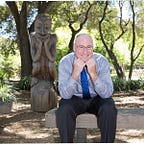Want Some Creativity? Crank-up the Constraints
Research on creativity and innovation provides an enlightening perspective on constraints. On first blush, it may seem that imagination will flourish when “anything goes.” Yet virtually all creative feats are accomplished by people, teams, and organizations that face challenging and immovable constraints. Much of the famous art created during the Renaissance in Europe, for example, was commissioned by benefactors — usually the church and governments — that bound artists to contracts that stipulated many details, including materials, colors, and sizes.
You’ve probably seen pictures of Michelangelo’s famous statue of David, and perhaps you’ve visited it at the Accademia Gallery in Florence. The statue was started, but never finished, by Agostino di Duccio in 1463. Michelangelo was hired in 1501 to complete it. The contract mandated that he finish it within two years. It also specified how the statue should look and be positioned. Within those guidelines (and the limits imposed by a hunk of marble that had been partially sculpted almost forty years earlier), Michelangelo was able to sculpt many nuances as he saw fit — and ignore many critics, including a government official who pestered him to make David’s nose smaller. The result was the Renaissance’s most famous sculpture — renowned for its great size and the striking contrast between David’s intense facial expression and his relaxed, almost nonchalant, pose.
Celebrated architect and furniture designer Charles Eames asserted that “design depends largely on constraints,” that an innovator’s “willingness and enthusiasm” to work within and around unchangeable elements determines success or failure. It isn’t a question of whether there will be constraints; it is a question of whether people have the will and skill to find ways around the constraints and transform them into virtues. (See this great old post by Diego Rodriguez for more on Eames love of constraints: Eames argued that “Design depends largely on constraints”).
Why do constraints help? Research on creativity and constraint demonstrates that, when options are limited, people generate more, rather than less, varied solutions — apparently because their attention is less scattered. For example, a study of college students who played a computer game found that they produced more solutions, and more imaginative solutions, when there were fewer allowable exits in the mazelike game.
In practice, I’ve noticed that the best teachers and coaches I work with at the Stanford d.school add lots of constraints on the people and teams they work with, and when teams hit wall, they add more rather fewer constraints to help them get out of the rut. I have especially learned a lot from Perry Klebahn and Jeremy Utley (pictured above); Perry has been teaching classes on creativity and design for close to 20 years and Stanford and the two have teamed-up in the last five years or so to teach classes on leadership and entrepreneurship — and they lead the d.school’s executive education efforts. Their natural tendency is to figure about how long an exercise, lecture, or assignment should take; and then cut the time in half. Or how much money is needed to build a prototype, and cut it on half — or by 90% — and try to figure out how to build and test it.
I teach a class with these two and Kathyrn Segovia (pictured above) called “d.leadership” where duos of students work with outside organizations to instill and spread creativity. We talk a lot about the importance of constraints, about how the students can promote creativity by putting severe time deadlines and financial pressures on their “clients” that force them to come up with new solutions. For example, one of our student teams worked with the San Francisco Opera, which usually plans events years ahead. The students (after much trial and error) convinced the opera staff (many of whom were VERY skeptical) to put on an informal event at a San Francisco bar that was called “Barely Opera.” The idea was to expose young and hip patrons(who attended the big, formal opera house in small numbers) that opera could be fun and even cool.
As this recent piece shows, Barely Opera was a big success, in part, because the opera staff only had a couple weeks to make it happen and because there were so many financial and logistical constraints. As a result, their attention focused on only the few things that mattered and they made decisions very quickly. Most of the usual trappings of the big opera house were removed (including the elaborate costumes, sets, and choreography), and a host of cheap and crazy experiments were attempted. Some of the experiments succeeded and some failed. But the event was a so successful, I believe, because the stunning talents of the performers and an appreciative audience remained and, in some ways, were more vivid and stirring in that more intimate and informal setting than in the big formal house. It has been over a year since the San Francisco Opera put on “Barely Opera.” They have since created something called “SF Opera Labs” and continue to experiment with different ways to bring people the joys of opera under more severe constraints than they ever thought possible — here is a film of one of their recent performances at a different San Francisco bar.
Of course, it is possible to remove too much, to give people too little time to think, a staff or budget that is too small, and so on — but my experience (and the evidence) suggests that, more often, people and organizations screw-up more and learn less when they have too much time, too many people, too many choices, and too much money. As my Stanford colleague Jeff Pfeffer likes to say, some of the worst mistakes are made by leaders and teams that “spend money as a substitute for thinking.”
The opening four paragraphs of this story are an edited excerpt from Scaling Up Excellence: Getting to More Without Settling for Less, by Robert I. Sutton and Huggy Rao.
